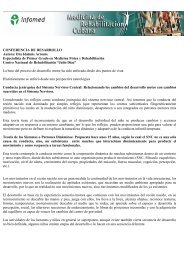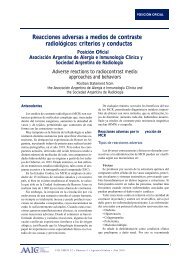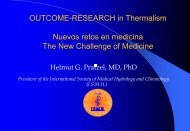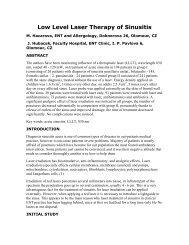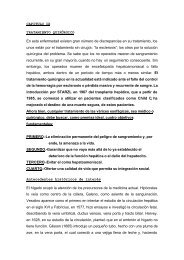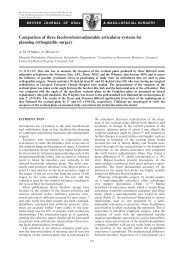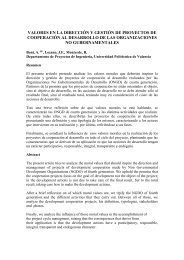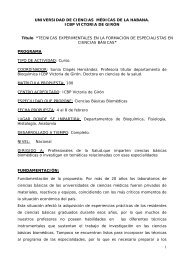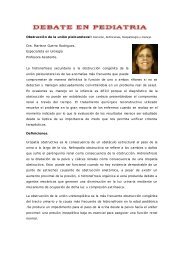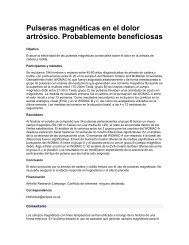pharmacology of medicinal plants and natural products
pharmacology of medicinal plants and natural products
pharmacology of medicinal plants and natural products
Create successful ePaper yourself
Turn your PDF publications into a flip-book with our unique Google optimized e-Paper software.
MEDICINAL PLANTS (NATURAL PRDUCTS)<br />
S105<br />
plasma concentration (C max<br />
) levels <strong>and</strong> area under<br />
curve (AUC).<br />
19.13. Betel leaf (Piper betle)<br />
The influence <strong>of</strong> two varieties <strong>of</strong> betel leaf (Piper betle<br />
Linn.) namely, the pungent Mysore <strong>and</strong> non-pungent<br />
Ambadi, was examined on digestive enzymes <strong>of</strong> pancreas<br />
<strong>and</strong> intestinal mucosa <strong>and</strong> on bile secretion in<br />
experimental rats. The results indicated that while<br />
these betel leaves do not influence bile secretion <strong>and</strong><br />
composition, they have a significant stimulatory influence<br />
on pancreatic lipase activity. The Ambadi<br />
variety <strong>of</strong> betel leaf has a positive stimulatory influence<br />
on intestinal digestive enzymes, especially<br />
lipase, amylase <strong>and</strong> disaccharidases whereas a slight<br />
lowering in the activity <strong>of</strong> these intestinal enzymes<br />
was seen when Mysore variety <strong>of</strong> betel leaf was administered.<br />
The latter variety also had a negative effect<br />
on pancreatic amylase. Further, both the betel<br />
leaf varieties have shown decreasing influence on<br />
pancreatic trypsin <strong>and</strong> chymotrypsin activities 245 .<br />
The anti-mutagenic potential has already been described<br />
earlier in this chapter.<br />
19.14. Mowrah (Madhuca latifolia)<br />
Mowrah (Madhuca latifolia) seeds are used as animal<br />
feed as they yield 40-50% edible fat <strong>and</strong> the meal<br />
contains saponins besides protein <strong>and</strong> high level <strong>of</strong><br />
carbohydrates. However, the seeds were found to be<br />
toxic when administered to young <strong>and</strong> adult rats at<br />
levels <strong>of</strong> 10 to 40% in diet. The animals showed<br />
marked inhibition <strong>of</strong> feed intake <strong>and</strong> loss <strong>of</strong> body<br />
weight resulting in mortalities. Histopathological examination<br />
revealed a gradation <strong>of</strong> damage from slight<br />
erosion <strong>of</strong> the tip <strong>of</strong> villi <strong>of</strong> intestinal mucous membrane<br />
to complete necrosis <strong>and</strong> destruction <strong>of</strong> it, with<br />
increasing amounts <strong>of</strong> mowrah seed meal in diets.<br />
The other significant change was a severe vacuolar<br />
degeneration <strong>of</strong> kidney tubular cells 246 .<br />
20. Phytochemistry<br />
Following are some <strong>of</strong> the studies carried out to find<br />
out the active principle <strong>of</strong> <strong>plants</strong>.<br />
20.1. Clausena anisata<br />
Two new carbozole alkaloids, designated as<br />
clausenol <strong>and</strong> clausenine, were isolated from alcoholic<br />
extract <strong>of</strong> the stem bark <strong>of</strong> Clausena anisata.<br />
Their structures were established as 1-hydroxy-6-<br />
methoxy-3-methylcarbazole <strong>and</strong> 1,6-dimethoxy-3-<br />
methyl carbazole, respectively, from physical <strong>and</strong><br />
chemical evidence <strong>and</strong> synthesis. Clausenol was<br />
found to be active against gram-positive <strong>and</strong> gramnegative<br />
bacteria <strong>and</strong> fungi 161 .<br />
20.2. Albizia lebbeck<br />
Three main saponins named albiziasaponins A, B<br />
<strong>and</strong> C were isolated from the bark <strong>of</strong> Albizia lebbeck<br />
<strong>and</strong> their structures were established through spectral<br />
analyses. These may be responsible for the<br />
antiallergic properties <strong>of</strong> Albizia lebbeck 247 .<br />
20.3. Ocimum sanctum<br />
Gas liquid chromatographic analysis <strong>of</strong> fixed oil <strong>of</strong><br />
Ocimum sanctum revealed the presence <strong>of</strong> five fatty<br />
acids (stearic, palmitic, oleic, linoleic <strong>and</strong> linolenic<br />
acids) which in further studies, demonstrated significant<br />
anti-inflammatory activity 35,36 .<br />
20.4. Bacopa monniera<br />
Chemical characterization <strong>of</strong> the plant, Bacopa<br />
monniera has been carried out by Garai et al 248,249 .<br />
Three new dammarane-type triterpenoid saponins,<br />
bacopasaponins A,B <strong>and</strong> C <strong>and</strong> a new dammarane<br />
type pseudojujubogenin glycoside, bacopa<br />
saponin D have been isolated <strong>and</strong> identified by<br />
spectroscopic methods <strong>and</strong> some chemical transformations.<br />
20.5. Cerpegia juncea<br />
From the chlor<strong>of</strong>orm extract <strong>of</strong> finely chopped, shade<br />
dried whole plant <strong>of</strong> Cerpegia juncea cerpegin has<br />
been derived which is the active principle responsible<br />
for its analgesic properties 30 .<br />
20.6. Ochna obtusata<br />
Column chromatography <strong>of</strong> chlor<strong>of</strong>orm extract shadedried<br />
<strong>and</strong> powdered stem bark <strong>of</strong> Ochna obtusata<br />
afforded an orange compound, crystallised from acetone<br />
which gave elemental analysis, IR, UV, HNMR<br />
<strong>and</strong> MS data corresponding to Prezewalskinone-B.<br />
This is probably the active principle that is responsible<br />
for the analgesic <strong>and</strong> anti-inflammatory properties<br />
<strong>of</strong> the plant 250 .<br />
20.7. Camellia sinensis<br />
Air-dried roots <strong>of</strong> Camellia sinensis were extracted<br />
by percolation with methanol at ambient




